
Radiation is a common hazard of space exploration and space agencies usually tend to avoid it for obvious reasons. It can be dangerous for astronauts and fatal to the microcircuitry of satellites. Why, then, is NASA sending its next unmanned mission right into the worst radiation hazard in the neighborhood? On August 23, two Radiation Belt Storm Probes (RBSP) will launch atop an Atlas V rocket from Cape Canaveral Air Force Station, Florida to study the radioactive Van Allen Belts
The Van Allen Belts were detected in 1958 by the first successful American satellite, Explorer I, and are named after their discoverer James Van Allen. They are two belts of radiation caused by the interaction of the Sun and the Earth’s magnetic field. This results in charged protons and electrons getting caught in the field like iron filings around a magnet. These fields are of importance because, on the one hand, they protect the Earth against radiation coming from space, but on the other hand, they are no-go areas for astronauts and unmanned craft.
The RBSP mission is set to explore both belts. The two radiation-shielded probes will fly through the radioactive areas of highly-charged particles to learn more about how they are changed by events on the Sun, such as solar flares and coronal discharges. This is motivated by more than mere curiosity. Space weather affects satellites, communications, terrestrial power grids and the exposure of air passengers to radiation. A severe weather event, such as a massive flare pointed straight at Earth, could even knock out electricity on half the planet and destroy most computers.
"The dramatic dynamics of Earth’s radiation belts caused by space weather are highly unpredictable," said Barry Mauk, RBSP project scientist at the Johns Hopkins University Applied Physics Laboratory (APL) in Laurel, Maryland. "One of the fundamental objectives of the RBSP mission is to use Earth’s magnetosphere as a natural laboratory to understand generally how radiation is created and evolves throughout the universe. There are many mysteries that need to be resolved."
A part of NASA’s Living With a Star Program, the RBSP mission is scheduled to last two years and will be controlled from the Goddard Space Flight Center in Greenbelt, Maryland.
